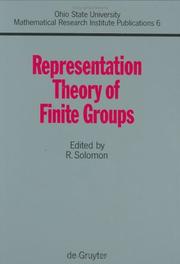| Listing 1 - 10 of 10 |
Sort by
|
Book
ISBN: 3540527095 0387527095 3540471154 9783540527091 Year: 1990 Volume: 1428 Publisher: Berlin: Springer,
Abstract | Keywords | Export | Availability | Bookmark
 Loading...
Loading...Choose an application
- Reference Manager
- EndNote
- RefWorks (Direct export to RefWorks)
Ordered algebraic structures --- Algebres regulieres --- Anneaux de groupes --- Groepsringen --- Group rings --- Modulaire representaties van groepen --- Modular representations of groups --- Reguliere algebra's --- Representations modulaires de groupes --- Tame algebras --- Modular representations of groups. --- Group rings. --- Tame algebras. --- 51 --- Algebras, Tame --- Associative algebras --- Representations of groups --- Group theory --- Rings (Algebra) --- Mathematics --- 51 Mathematics
Book
ISBN: 3319919970 3319919989 Year: 2018 Publisher: Cham : Springer International Publishing : Imprint: Springer,
Abstract | Keywords | Export | Availability | Bookmark
 Loading...
Loading...Choose an application
- Reference Manager
- EndNote
- RefWorks (Direct export to RefWorks)
This carefully written textbook provides an accessible introduction to the representation theory of algebras, including representations of quivers. The book starts with basic topics on algebras and modules, covering fundamental results such as the Jordan-Hölder theorem on composition series, the Artin-Wedderburn theorem on the structure of semisimple algebras and the Krull-Schmidt theorem on indecomposable modules. The authors then go on to study representations of quivers in detail, leading to a complete proof of Gabriel's celebrated theorem characterizing the representation type of quivers in terms of Dynkin diagrams. Requiring only introductory courses on linear algebra and groups, rings and fields, this textbook is aimed at undergraduate students. With numerous examples illustrating abstract concepts, and including more than 200 exercises (with solutions to about a third of them), the book provides an example-driven introduction suitable for self-study and use alongside lecture courses.
Algebra. --- Group theory. --- Associative Rings and Algebras. --- Commutative Rings and Algebras. --- Group Theory and Generalizations. --- Category Theory, Homological Algebra. --- Groups, Theory of --- Substitutions (Mathematics) --- Algebra --- Mathematics --- Mathematical analysis --- Representations of algebras. --- Associative rings. --- Rings (Algebra). --- Commutative algebra. --- Commutative rings. --- Category theory (Mathematics). --- Homological algebra. --- Rings (Algebra) --- Homological algebra --- Algebra, Abstract --- Homology theory --- Category theory (Mathematics) --- Algebra, Homological --- Algebra, Universal --- Group theory --- Logic, Symbolic and mathematical --- Topology --- Functor theory --- Algebraic rings --- Ring theory --- Algebraic fields --- Categories (Mathematics) --- Algebra, Homological.
Multi
ISBN: 9783319919980 9783319919973 Year: 2018 Publisher: Cham Springer International Publishing
Abstract | Keywords | Export | Availability | Bookmark
 Loading...
Loading...Choose an application
- Reference Manager
- EndNote
- RefWorks (Direct export to RefWorks)
This carefully written textbook provides an accessible introduction to the representation theory of algebras, including representations of quivers.The book starts with basic topics on algebras and modules, covering fundamental results such as the Jordan-Hölder theorem on composition series, the Artin-Wedderburn theorem on the structure of semisimple algebras and the Krull-Schmidt theorem on indecomposable modules. The authors then go on to study representations of quivers in detail, leading to a complete proof of Gabriel's celebrated theorem characterizing the representation type of quivers in terms of Dynkin diagrams.Requiring only introductory courses on linear algebra and groups, rings and fields, this textbook is aimed at undergraduate students. With numerous examples illustrating abstract concepts, and including more than 200 exercises (with solutions to about a third of them), the book provides an example-driven introduction suitable for self-study and use alongside lecture courses.
Group theory --- Category theory. Homological algebra --- Ordered algebraic structures --- Algebra --- algebra --- wiskunde --- Algebra. --- Group theory. --- Algèbre. --- Groupes, Théorie des.

ISBN: 9781846280405 1846280400 1846284902 Year: 2006 Publisher: London: Springer,
Abstract | Keywords | Export | Availability | Bookmark
 Loading...
Loading...Choose an application
- Reference Manager
- EndNote
- RefWorks (Direct export to RefWorks)
Lie groups and Lie algebras have become essential to many parts of mathematics and theoretical physics, with Lie algebras a central object of interest in their own right. This book provides an elementary introduction to Lie algebras based on a lecture course given to fourth-year undergraduates. The only prerequisite is some linear algebra and an appendix summarizes the main facts that are needed. The treatment is kept as simple as possible with no attempt at full generality. Numerous worked examples and exercises are provided to test understanding, along with more demanding problems, several of which have solutions. Introduction to Lie Algebras covers the core material required for almost all other work in Lie theory and provides a self-study guide suitable for undergraduate students in their final year and graduate students and researchers in mathematics and theoretical physics.
Lie algebras. --- Lie algebras --- 512.81 --- 512.81 Lie groups --- Lie groups --- Algebras, Lie --- Algebra, Abstract --- Algebras, Linear
Digital
ISBN: 9781846284908 Year: 2006 Publisher: London Springer-Verlag London Limited
Abstract | Keywords | Export | Availability | Bookmark
 Loading...
Loading...Choose an application
- Reference Manager
- EndNote
- RefWorks (Direct export to RefWorks)
Algebra --- Mathematical physics --- algebra --- wiskunde --- fysica
Multi
ISBN: 9783540469599 Year: 2007 Publisher: Berlin, Heidelberg Springer-Verlag Berlin Heidelberg
Abstract | Keywords | Export | Availability | Bookmark
 Loading...
Loading...Choose an application
- Reference Manager
- EndNote
- RefWorks (Direct export to RefWorks)
The first half of this book contains the text of the first edition of LNM volume 830, Polynomial Representations of GLn. This classic account of matrix representations, the Schur algebra, the modular representations of GLn, and connections with symmetric groups, has been the basis of much research in representation theory. The second half is an Appendix, and can be read independently of the first. It is an account of the Littelmann path model for the case gln. In this case, Littelmann's 'paths' become 'words', and so the Appendix works with the combinatorics on words. This leads to the repesentation theory of the 'Littelmann algebra', which is a close analogue of the Schur algebra. The treatment is self- contained; in particular complete proofs are given of classical theorems of Schensted and Knuth.
Group theory --- Ordered algebraic structures --- Algebra --- Mathematical analysis --- Discrete mathematics --- algebra --- analyse (wiskunde) --- discrete wiskunde --- wiskunde
Book
ISBN: 9783540469599 Year: 2007 Publisher: Berlin Heidelberg Springer Berlin Heidelberg
Abstract | Keywords | Export | Availability | Bookmark
 Loading...
Loading...Choose an application
- Reference Manager
- EndNote
- RefWorks (Direct export to RefWorks)
The first half of this book contains the text of the first edition of LNM volume 830, Polynomial Representations of GLn. This classic account of matrix representations, the Schur algebra, the modular representations of GLn, and connections with symmetric groups, has been the basis of much research in representation theory. The second half is an Appendix, and can be read independently of the first. It is an account of the Littelmann path model for the case gln. In this case, Littelmann's 'paths' become 'words', and so the Appendix works with the combinatorics on words. This leads to the repesentation theory of the 'Littelmann algebra', which is a close analogue of the Schur algebra. The treatment is self- contained; in particular complete proofs are given of classical theorems of Schensted and Knuth.
Group theory --- Ordered algebraic structures --- Algebra --- Mathematical analysis --- Discrete mathematics --- algebra --- analyse (wiskunde) --- discrete wiskunde --- wiskunde
Book
ISBN: 9781846284908 Year: 2006 Publisher: London Springer London
Abstract | Keywords | Export | Availability | Bookmark
 Loading...
Loading...Choose an application
- Reference Manager
- EndNote
- RefWorks (Direct export to RefWorks)
Lie groups and Lie algebras have become essential to many parts of mathematics and theoretical physics, with Lie algebras a central object of interest in their own right. Based on a lecture course given to fourth-year undergraduates, this book provides an elementary introduction to Lie algebras. It starts with basic concepts. A section on low-dimensional Lie algebras provides readers with experience of some useful examples. This is followed by a discussion of solvable Lie algebras and a strategy towards a classification of finite-dimensional complex Lie algebras. The next chapters cover Engel's theorem, Lie's theorem and Cartan's criteria and introduce some representation theory. The root-space decomposition of a semisimple Lie algebra is discussed, and the classical Lie algebras studied in detail. The authors also classify root systems, and give an outline of Serre's construction of complex semisimple Lie algebras. An overview of further directions then concludes the book and shows the high degree to which Lie algebras influence present-day mathematics. The only prerequisite is some linear algebra and an appendix summarizes the main facts that are needed. The treatment is kept as simple as possible with no attempt at full generality. Numerous worked examples and exercises are provided to test understanding, along with more demanding problems, several of which have solutions. Introduction to Lie Algebras covers the core material required for almost all other work in Lie theory and provides a self-study guide suitable for undergraduate students in their final year and graduate students and researchers in mathematics and theoretical physics.
Algebra --- Mathematical physics --- algebra --- wiskunde --- fysica
Book

ISBN: 9783110806298 Year: 2012 Publisher: Berlin Boston
Abstract | Keywords | Export | Availability | Bookmark
 Loading...
Loading...Choose an application
- Reference Manager
- EndNote
- RefWorks (Direct export to RefWorks)


ISBN: 9783110806298 9783110158069 Year: 2012 Publisher: Berlin ;; Boston De Gruyter
Abstract | Keywords | Export | Availability | Bookmark
 Loading...
Loading...Choose an application
- Reference Manager
- EndNote
- RefWorks (Direct export to RefWorks)
| Listing 1 - 10 of 10 |
Sort by
|

 Search
Search Feedback
Feedback About UniCat
About UniCat  Help
Help News
News